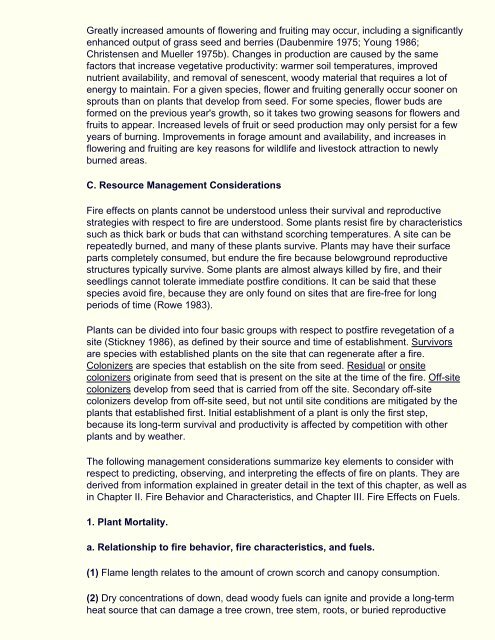FIRE EFFECTS GUIDE - National Wildfire Coordinating Group
FIRE EFFECTS GUIDE - National Wildfire Coordinating Group
FIRE EFFECTS GUIDE - National Wildfire Coordinating Group
You also want an ePaper? Increase the reach of your titles
YUMPU automatically turns print PDFs into web optimized ePapers that Google loves.
Greatly increased amounts of flowering and fruiting may occur, including a significantly<br />
enhanced output of grass seed and berries (Daubenmire 1975; Young 1986;<br />
Christensen and Mueller 1975b). Changes in production are caused by the same<br />
factors that increase vegetative productivity: warmer soil temperatures, improved<br />
nutrient availability, and removal of senescent, woody material that requires a lot of<br />
energy to maintain. For a given species, flower and fruiting generally occur sooner on<br />
sprouts than on plants that develop from seed. For some species, flower buds are<br />
formed on the previous year's growth, so it takes two growing seasons for flowers and<br />
fruits to appear. Increased levels of fruit or seed production may only persist for a few<br />
years of burning. Improvements in forage amount and availability, and increases in<br />
flowering and fruiting are key reasons for wildlife and livestock attraction to newly<br />
burned areas.<br />
C. Resource Management Considerations<br />
Fire effects on plants cannot be understood unless their survival and reproductive<br />
strategies with respect to fire are understood. Some plants resist fire by characteristics<br />
such as thick bark or buds that can withstand scorching temperatures. A site can be<br />
repeatedly burned, and many of these plants survive. Plants may have their surface<br />
parts completely consumed, but endure the fire because belowground reproductive<br />
structures typically survive. Some plants are almost always killed by fire, and their<br />
seedlings cannot tolerate immediate postfire conditions. It can be said that these<br />
species avoid fire, because they are only found on sites that are fire-free for long<br />
periods of time (Rowe 1983).<br />
Plants can be divided into four basic groups with respect to postfire revegetation of a<br />
site (Stickney 1986), as defined by their source and time of establishment. Survivors<br />
are species with established plants on the site that can regenerate after a fire.<br />
Colonizers are species that establish on the site from seed. Residual or onsite<br />
colonizers originate from seed that is present on the site at the time of the fire. Off-site<br />
colonizers develop from seed that is carried from off the site. Secondary off-site<br />
colonizers develop from off-site seed, but not until site conditions are mitigated by the<br />
plants that established first. Initial establishment of a plant is only the first step,<br />
because its long-term survival and productivity is affected by competition with other<br />
plants and by weather.<br />
The following management considerations summarize key elements to consider with<br />
respect to predicting, observing, and interpreting the effects of fire on plants. They are<br />
derived from information explained in greater detail in the text of this chapter, as well as<br />
in Chapter II. Fire Behavior and Characteristics, and Chapter III. Fire Effects on Fuels.<br />
1. Plant Mortality.<br />
a. Relationship to fire behavior, fire characteristics, and fuels.<br />
(1) Flame length relates to the amount of crown scorch and canopy consumption.<br />
(2) Dry concentrations of down, dead woody fuels can ignite and provide a long-term<br />
heat source that can damage a tree crown, tree stem, roots, or buried reproductive
















